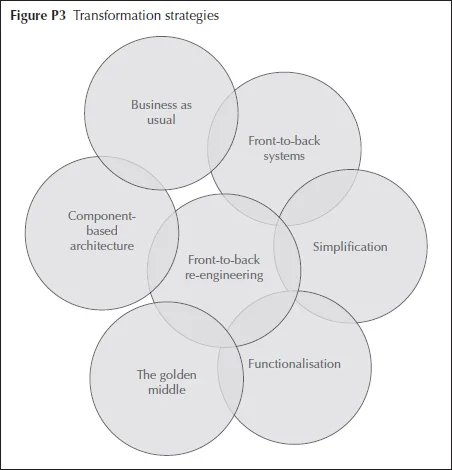Part 3: Historic Approaches to Transformation
Foreword
Introduction
Part 1: What the Infrastructure Needs to do
Trades and Products
Where do Trades Come From?
The Purpose of the Infrastructure
Typical Infrastructure
Part 2: The Problems with Trade Processing Infrastructure
The Problems
The Evolution of Technical Complexity
The Regulatory Challenges
The Complexity Cycle
Part 3: Historic Approaches to Transformation
BAU/Incremental Change
Front-to-back Re-engineering
Functionalisation, aka “Factories”
Front-to-back Systems
The Golden Middle
Simplification
Part 4: New Approaches to Infrastructure
Digital
Cloud and Utilities
Artificial Intelligence and Robotics
Big Data and Analytics
Blockchain/Distributed Ledger Technology
Distributed Ledger Technology: Hybrid Approach
Nirvana?
Since the mid-1990s, banks and other major financial institutions have been trying to radically transform their trading infrastructure by pursuing a small number of interrelated strategies (see Figure P3). Some of these strategies are architectural blueprints such as “functionalisation” and “component-based architecture”. Others would be better described as approaches to change, and include “front-to-back re-engineering” and “simplification”.


Every major bank has tried most of these (sometimes under different names) approaches at various times. Although a great deal of money has been spent, easily running into the billions of dollars, results have been (to put it politely) mixed. Typically, the bigger and more ambitious the programme, the smaller the return on the investment. Some programmes have not just failed to show a return, but probably damaged the overall infrastructure. However, no approach has failed consistently. In at least some banks (generally on a smaller scale), most have “worked” to some extent. This means it is worth looking at each of these approaches in turn to understand the costs, benefits and barriers to successful
Copyright Infopro Digital Limited. All rights reserved.
As outlined in our terms and conditions, https://www.infopro-digital.com/terms-and-conditions/subscriptions/ (point 2.4), printing is limited to a single copy.
If you would like to purchase additional rights please email info@risk.net
Copyright Infopro Digital Limited. All rights reserved.
You may share this content using our article tools. As outlined in our terms and conditions, https://www.infopro-digital.com/terms-and-conditions/subscriptions/ (clause 2.4), an Authorised User may only make one copy of the materials for their own personal use. You must also comply with the restrictions in clause 2.5.
If you would like to purchase additional rights please email info@risk.net










